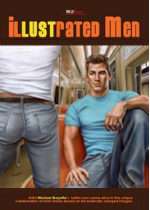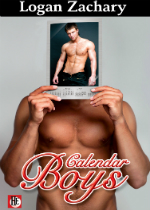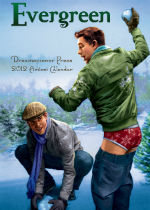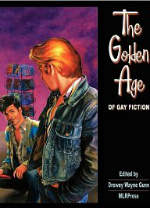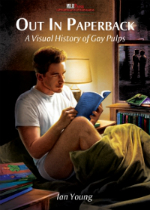Book Lovers: Big Picture Storybooks
Author: Dick Smart
December 19, 2012
Mother always decorated the tree sparsely with a few precious ornaments that she had collected over the years. The tree stood in the pale winter light coming in from the large picture window, the room slightly chilly but warmed by the smells of cinnamon toast and hot chocolate. We had opened our presents the night before, after Christmas Eve service, but Mother always made us leave them under the tree still snuggled in their colorful tissue paper. Enchanted by dreams of my Christmas treasures, I would wake up on Christmas morning giddy with anticipation and slide down the stairs to find my favorite gift—a big storybook filled with pictures. One I still have is Thirteen by Remy Charlip and Jerry Joyner (Parents Magazine Press, 1975), whose subtle charm helped me to begin to understand the big picture of my own gayness.
Now that I have become a man I have not quite put away childish things. Instead I hope to find manly picture storybooks tied up in ribbons under my aluminum tree. Illustrated Men is a big book of stories illustrating the pastel paintings of well-known romance cover artist Michael Breyette (MLR Press, 2010, www.mlrbooks.com). On Breyette’s website, www.breyette.com, he describes himself as a “self-taught artist” and while meticulously executed, his paintings retain a raw freshness. The same can be said of the stories accompanying each picture. In the introduction, he writes, “I thought it would be fun to launch a contest and invite friends, fans of my art, amateur scribes, professional writers, really anyone who wanted, to pick a painting from my body of work and build a short story around it.” The stories live up to their inspirations—each one is a winner.
William Maltese creates a work of high literary art when he focuses a book of his short stories and poems around the work of Dutch artist Johan Ekkel in Maltese/Ekkel (MLR Press, 2012). Not all of Ekkel’s drawings are “pretty” in the conventional sense and many of Maltese’s stories are likewise experimental, rising fully to the power of Ekkel’s work through the use of a variety of literary genres, eroticism, poetry, sci fi and romance. The simplicity of the writing is its strength, revealing a rich complexity beneath. For example, in the poem, “I, Addict”:
He begged me not to go.
For our adopted daughter’s sake.
For my sake.
For his sake.
For the sake of our marriage and
relationship.
I went anyway and
Bet everything on one throw of the dice.
And rolled snake eyes.
Maltese’s website, www.williammaltese.com, features a gallery of portraits each a different artist’s interpretation of a photo of a young nude Maltese in an amazing variety of mediums and styles—a fitting homage to one of gay literature’s living pioneers. For more Ekkel, see http://www.gayart.nl/.
The Pugilists: Other Erotic Tales by “Doc” Hoskins, Jr. was due out this month from STARbooks Press (www.starbookspress.com) but publication has been postponed to 2013. The book was to be a sequel to Hoskins’ earlier The Pugilists: Erotic Boxing Adventures (www.the-pugilist.com/pugilist.htm). Hoskins is an Amateur/Masters Division boxer and a holder of the Leatherman of Color title. TLAGay.com describes Hoskins’ stories as “sexually charged pugilistic exploits of various boxers from all walks of life, including fantasy and science fiction”—but then tags the book “Currently Unavailable.” Hoskins’ new collection is going to be illustrated by New York street artist Anthony Gonzales. Gonzales’ work was previously seen in the almost illegally hot art book, Bronx Boys (Bruno Gmünder, 2008, with an introduction by Harvey Redding, www.brunogmuender.com). Gonzales captures an American primitivism in his work that’s akin to men’s room graffiti art—think Grandma Moses in the ‘hood. For more Gonzales, click here.
One recent release that one might have expected to feature illustrations, but doesn’t, is Calendar Boys by Logan Zachary (Bold Strokes Books, 2012, www.boldstrokesbooks.com). Evoking the girly pin-up calendars we remember hanging in our fathers’ garages, Zachary’s delightful collection of erotic romance stories presents a different “pin-up” guy’s story for us each month and season of the year. A picture may be worth a thousand words but Zachary’s stories each have a fresh enough kick that the calendar boys he paints in our mind’s eye are as vivid as any actual centerfold. To get more Zachary, check out, www.loganzacharydicklit.com.
I hope during this Christmas season you’ve been waking up to find a new holiday romance in your e-stocking every morning from Dreamspinner Press’ 2012 Advent Calendar, Evergreen (www.dreamspinnerpress.com). The calendar’s cover is by one of my favorite romance cover artists, the adorable Paul Richmond. Richmond aspired to become an animator for Disney Studios and his art has the luminous, transparent quality of a film animation cell. While his work at first glance may seem sweet but cartoonish, there is an undertone of melancholy, especially in his more autobiographical paintings, that connotes a deep longing. Richmond has self-published two books of his art, Cheesecake Boys, the eponymously titled collection of some of his pin-up boys, and Ins and Outs, a more personal collection of his autobiographical paintings that serve as a portrait of the artist as a young man, both available through his website at www.paulrichmondstudio.com.
Many romance authors create their own cover art, and m/m romance author Jordan Castillo Price at JCP Books has made his cover work available as a free downloadable pdf at JCP Books (jcpbooks.com). Price has written several m/m romance series in different sub-genres and in 2008 started his own e-book publishing site, JCP Books, to retain creative control over his work from cover to content. Since then he has added the work of three well-known m/m authors—Josh Lanyon, Sean Kennedy and Clare London—to JCP’s catalog. Among the interesting publishing experiments that Price is trying at JCP Books is his promotional Pay-What-You-Wish books. While offering the books at the retail price, JCP invites those who wish to do so to download the books for free. The downloadable pdf of his cover art contains all of his series and standalone covers.
What makes the pdf even more interesting is Price’s commentary about how he designed the covers, why he used the color motifs that he selected, where he finds his gorgeous models and other insights into his creative process. My favorite is the bespeckled gay pilot, Paul Cronin, from the Turbulence series featured on the cover of Into the Bermuda Triangle. Price’s covers for the series evoke the travel posters of the early mid-20th century, while retaining a retro-futurist look for the character. The Traveling Morpheus series features stunning face portraits that resemble a cross between a Warhol screen print and a Calvin Klein ad.
The gorgeous covers of many a gay romance have more than sold the book, they have become icons of gay culture. Being able to tell a book by its cover was crucial to early closeted gay readers. Two books that serve as companion studies of gay pulp fiction—which is to say early gay literature—emphasize the importance of cover art in signaling to closeted gay men in the mid-decades of the last century the homosexual content hidden inside.
The Golden Age of Gay Fiction, edited by Drewey Wayne Gunn (MLR Press, 2009) gathers in-depth essays by gay and m/m literary scholars and writers to explore the golden dawn of gay fiction in the forties and fifties and sixties. The text is abundantly illustrated with examples of vintage pulp cover art. The book’s cover is by contemporary artist Paul Richmond and perfectly illustrates the spirit of the pulp age with two Levi-jacketed impish Tom of Finlands with ducktails eyeing each other at a drug-store pulp bookrack.
Gunn observes in his introduction that many early gay authors, “working under the heterosexual hegemony presented homosexuality…like some modern-day Virgil guiding the Dantean reader through the homosexual inferno.” Other works offered what Gunn calls an “apologia” for homosexuality. Surprisingly many of these early novels, Gunn notes, have happy endings and homo heroes that “neither beg for acceptance nor seek justification for their existence from straight readers.” In 1948 with the publication of the famous Kinsey Report, gay men and lesbian women became aware that they were not alone. In the same year were published two of gay literature’s most seminal novels, Gore Vidal’s The City and the Pillar and Truman Capote’s Other Voices, Other Rooms. Gunn quotes from Felice Picano’s memoir, Art and Sex in Greenwich Village, to highlight how the gay pulps popularized Kinsey’s message:
“What the pulps offered readers and the rare if more literary novels either couldn’t or didn’t seem interested in offering was a sense of gay people pervading regular society on a day-by-day basis. According to the pulps, gay men and lesbians could be found everywhere: in business, in prison, ranching, piloting submarines, drill instructing in the army, on oil rigs, anywhere you looked.”
Gunn writes, “It is among the pulps that such distinctive genres as gay horror, the gay gothic, to a large extent the gay mystery and the gay spy story, the gay cop story, and the gay western developed.” He also notes the emergence of the “gay romantic pastoral,” such as Song of the Loon. Gunn shows pleased “amusement” over “a resurgence of gay erotica in the new millennium, especially an eroticized rediscovery of genres such as the gay romance, the gay western, and the gay mystery, now made available in e-books,” the virtual pulp fiction of our post-gay era.
Gay literature initially had to signal itself in coded covers of half-clad women and bewildered looking men but as gay culture began to form a self-conscious identity, so also many of the covers became less coded and more blatant. Out in Paperback: A Visual History of Gay Pulps, by Ian Young, (MLR Press, 2012) is a beautifully illustrated decoding of gay pulp covers. The book’s clever cover painting by contemporary cover artist Paul Richmond illustrates how a young gay man back in the fifties might have put some of these books to good use; some of the coded signals early pulp covers used to attract gay readers are hidden in the painting.
Young points out that the covers signaled the homosexual content inside to gay readers. He writes, “Even people who never bought a gay paperback nevertheless encountered the covers with their all-important pictures, face out on drug-store and dime-store racks. Those pictures and their underlying patterns and recurring motifs, illustrate not only the books they adorn but also some of Western culture’s broadly shared ideas and beliefs” about homosexuality. Young decodes common pulp cover motifs, borrowing from Parker Tyler’s classic study, Screening the Sexes: Homosexuality in the Movies. He explores “the prevalence of certain motifs, among them the solitary man, suggesting isolation; the triangle of two men and a woman,” or of two women and a man, and also “the concerned or consoling woman” and the “disconsolate man,” that Young says suggests the gay man’s heterosexual impotence. Young says that “the looming or lurking man” on many covers conveys the idea of “predatory” homosexuality. He observes:
One frequent variant is the both-looking-away motif in which two men—with or without a woman—are depicted looking away from each other, suggesting a nonrecognition or denial of attraction. This has proved particularly durable; as late as 2005 it was used for the iconic film poster—and subsequent paperback cover—for Annie Proulx’s tragic Western romance, Brokeback Mountain.
Young notes that Mary Renault, who wrote The Charioteer, was “one of a surprising number of women who wrote novels about gay men” in the golden age of pulps, long antedating the contemporary controversy over women m/m romance writers. Like Gunn, Young notes the emergence of gay genre fiction in the pulps: “Not only gay detective stories, but gay science fiction, gay fantasy, and even one or two gay westerns made it to the paperback racks.” He points to Vincent Virga’s gay gothic romance Gaywick as a harbinger of contemporary gay romance. He says Virga “adapted standard story features of a heretofore heterosexual genre…Avon’s cover duplicates the standard ladies’ gothic illustration of the period, with the young woman replaced by a pretty blond male. Even that staple of gothic romance cover art—the single light shining in the window of a dark mansion has been retained.”
In an afterword by David Mason we learn that the large collection of gay paperbacks that Young collected over the years and that form the basis of this beautifully illustrated study now reside at the University of Toronto as part of the University’s Sexual Diversities program. One of the motifs of gay pulp cover art is the keyhole through which we observe closeted gay life; we hope that through Gunn and Young’s fascinating works of research and preservation that this keyhole view remains open so that future gay generations can get the big picture of our past.

